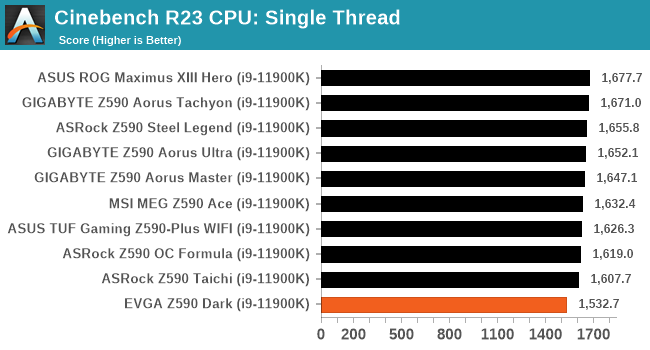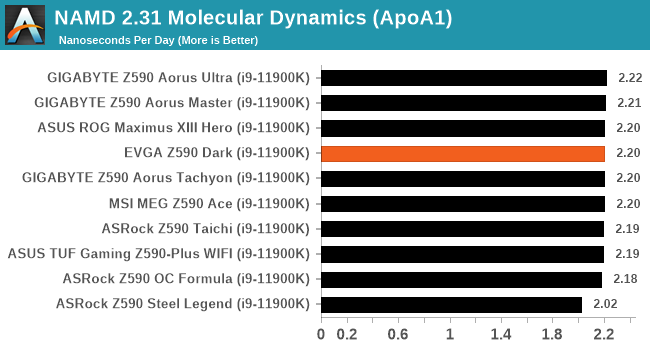The EVGA Z590 Dark Motherboard Review: For Extreme Enthusiasts
by Gavin Bonshor on October 15, 2021 9:00 AM ESTCPU Performance, Short Form
For our motherboard reviews, we use our short form testing method. These tests usually focus on if a motherboard is using MultiCore Turbo (the feature used to have maximum turbo on at all times, giving a frequency advantage), or if there are slight gains to be had from tweaking the firmware. We put the memory settings at the CPU manufacturers suggested frequency, making it very easy to see which motherboards have MCT enabled by default.
For Z590 we are running using Windows 10 64-bit with the 20H2 update.
Rendering - Blender 2.79b: 3D Creation Suite
A high profile rendering tool, Blender is open-source allowing for massive amounts of configurability, and is used by a number of high-profile animation studios worldwide. The organization recently released a Blender benchmark package, a couple of weeks after we had narrowed our Blender test for our new suite, however their test can take over an hour. For our results, we run one of the sub-tests in that suite through the command line - a standard ‘bmw27’ scene in CPU only mode, and measure the time to complete the render.

Rendering – POV-Ray 3.7.1: Ray Tracing
The Persistence of Vision Ray Tracer, or POV-Ray, is a freeware package for as the name suggests, ray tracing. It is a pure renderer, rather than modeling software, but the latest beta version contains a handy benchmark for stressing all processing threads on a platform. We have been using this test in motherboard reviews to test memory stability at various CPU speeds to good effect – if it passes the test, the IMC in the CPU is stable for a given CPU speed. As a CPU test, it runs for approximately 1-2 minutes on high-end platforms.

Rendering - Crysis CPU Render
One of the most oft used memes in computer gaming is ‘Can It Run Crysis?’. The original 2007 game, built in the Crytek engine by Crytek, was heralded as a computationally complex title for the hardware at the time and several years after, suggesting that a user needed graphics hardware from the future in order to run it. Fast forward over a decade, and the game runs fairly easily on modern GPUs, but we can also apply the same concept to pure CPU rendering – can the CPU render Crysis? Since 64 core processors entered the market, one can dream. We built a benchmark to see whether the hardware can.
For this test, we’re running Crysis’ own GPU benchmark, but in CPU render mode. This is a 2000 frame test, which we run over a series of resolutions from 800x600 up to 1920x1080. For simplicity, we provide the 1080p test here.

Rendering - Cinebench R23: link
Maxon's real-world and cross-platform Cinebench test suite has been a staple in benchmarking and rendering performance for many years. Its latest installment is the R23 version, which is based on its latest 23 code which uses updated compilers. It acts as a real-world system benchmark that incorporates common tasks and rendering workloads as opposed to less diverse benchmarks which only take measurements based on certain CPU functions. Cinebench R23 can also measure both single-threaded and multi-threaded performance.


Compression – WinRAR 5.90: link
Our WinRAR test from 2013 is updated to the latest version of WinRAR at the start of 2014. We compress a set of 2867 files across 320 folders totaling 1.52 GB in size – 95% of these files are small typical website files, and the rest (90% of the size) are small 30-second 720p videos.

3DPMv2.1 – 3D Movement Algorithm Test: link
3DPM is a self-penned benchmark, taking basic 3D movement algorithms used in Brownian Motion simulations and testing them for speed. High floating point performance, MHz, and IPC win in the single thread version, whereas the multithread version has to handle the threads and loves more cores. For a brief explanation of the platform agnostic coding behind this benchmark, see my forum post here.

NAMD 2.13 (ApoA1): Molecular Dynamics
One frequent request over the years has been for some form of molecular dynamics simulation. Molecular dynamics forms the basis of a lot of computational biology and chemistry when modeling specific molecules, enabling researchers to find low energy configurations or potential active binding sites, especially when looking at larger proteins. We’re using the NAMD software here, or Nanoscale Molecular Dynamics, often cited for its parallel efficiency. Unfortunately the version we’re using is limited to 64 threads on Windows, but we can still use it to analyze our processors. We’re simulating the ApoA1 protein for 10 minutes, and reporting back the ‘nanoseconds per day’ that our processor can simulate. Molecular dynamics is so complex that yes, you can spend a day simply calculating a nanosecond of molecular movement.












27 Comments
View All Comments
gavbon - Saturday, October 16, 2021 - link
Value is all relative to what a user is willing to spend. For extreme overclocking, that's dependant on the qualityAlistair - Friday, October 15, 2021 - link
Quick! Buy it 2 weeks before it is obsolete! Hurry! ;)Silver5urfer - Friday, October 15, 2021 - link
Obsolete ? LGA1700 ADL is going to be a generation first product on DDR5 with Gear 4 and Gear 2, on top of new trash cores shoved in because of high power consumption. Plus a basic PCIe5.0 for GPU X16 only. Yeah more DMI and more lanes but questionable Intel Hardware Scheduler on top of the big little BS first adoption on top. Plus the added cost for all the new tech.If we follow the leaks ADL barely matches Zen 3 in SMT and perhaps in ST boost how it translates to real world ? Gotta see, RKL was also like that but came at huge power spike and not much in SMT. This new ADL has inferior cores going to magically beat in real workloads ? Nah.
Nope this platform is not Obsolete only issue is PCIe NVMe SSD slots aren't there and must use PCIe slot and RAID them. If used with 10th gen then PCIe3.0 will be a negative on the GPU lane when used with NVMe SSDs.
Alistair - Friday, October 15, 2021 - link
You can buy it using DDR4 and it is in no way inferior, if you don't want DDR5. The new big cores are just better than Rocket Lake big cores, so who cares about the small cores, those are just extra. With Intel you can even disable any cores you don't want. Why are you comparing to AMD when we are talking about Z590 being obsolete vs the latest Intel, AMD has nothing to do with my comment. A lot of funny responses in your comment.Silver5urfer - Friday, October 15, 2021 - link
It's not obsolete is the fact gauging by the performance it offers. The fact that AMD was mentioned is because on how RKL was compared to it and had ST advantage but nothing in SMT and huge power draw.Small cores no one cares ? Are you drunk lol. Intel is screaming from their chest that these 8x Atom trash are better than SMT cores AND the fact on how the Cinebench leaks showed it barely reaches to AMD's top SKU in the same tests. And you think disabling those small cores is going to net you the performance boost that Intel is claiming, what a pathetic joke. Those cores are needed if you disable you lose SMT Multicore advantage. Period. AND finally DDR4 is Gear 2 by default there was a latest leak saying Gear 1 is maxed out at 3600MHz probably similar or could be worse than RKL IMC.
You took the AMD and other aspects and discarded everything related to being a new platform on top of the extra costs, done with your kind of garbo useless replies.
amnesia0287 - Friday, October 15, 2021 - link
Assuming anyone will be able to actually find them in stock. I wasn’t under the impression intel had solved the silicon shortages.Wrs - Sunday, October 17, 2021 - link
Oh come on, Z590 is at higher risk of obsolescence than a typical chipset. Every CPU supported is 14nm. You could be stuck between the power hungry RKL and the soon to be two generation lag of Comet Lake. Both already have problems comparing to Ryzen.LGA1700 should offer you the ability to reuse ddr4. The number of technologies being added is what obsolescence is about, no? The only thing to save Z590 from obsolescence is if ADL is trash, and you simply don't know that, not from the public leaks.
Flying Aardvark - Sunday, October 17, 2021 - link
That makes no sense. RKL is the fastest gaming CPU where it counts, minimum frames per second / 99th percentile. https://www.tomshardware.com/reviews/best-cpus,398... Take a look for yourself. Who cares if it's 14nm? Larger process nodes have their advantages as well. Performance is what matters. If you're looking to save on energy, buy yourself a tablet. The only thing obsolete is whatever you're running in your rig today instead. Ryzen has plenty of problems, you're just not informed. Stay salty, poor boy.Wrs - Sunday, October 17, 2021 - link
Obsolescence is about what's around the corner, not what you have today. I just think buying any Z590 today is asking for buyer's remorse. Around the corner, we're expecting expanded cache Ryzens for AM4 - which may not be much except for gaming - and ADL on Z690. ADL consists of two new cores on a finer process (I consider it coequal with Zen 3's 7nm), translating to a higher overall core/thread count and cache, and ITD with all its potential game optimizations. Unless ADL has a poor showing or developers don't support ITD, won't ADL make Z590 suddenly feel lackluster? It could be a mild Pentium 4 moment.It's true that RKL holds pole position for most games right now. It's just that the edge over a 5800x is really small, the cost of that power budget is substantial, and many of us weigh other workloads too, including multitasking while gaming.
Silver5urfer - Monday, October 18, 2021 - link
As a platform probably yes because of only I/O - PCIe3.0 for CML and RKL gettin Gen 4 but at 8C max and insane ABT power spiking and heat. In terms of performance not yet. ADL is a brand new platform and with questionable core design it's already having a lot of news around DRM, Application optimizations and etc. Why should I pay for beta testing a product ? Esp when the DDR5 is so new and PCIe5.0 barely has any effect and the whole socket longevity along with Intel Thread Director drama and Win11 shenanigans ??Intel clearly lost their way. RKL was the first sign of that, IMC massively downgraded on that. With ADL DDR4 is not going to run at 4000MHz C15. It's not going to happen. The leaks show max of 3600MHz just like AMD, AM4 platform has a TON of issues, I was on the verge on pulling a trigger on Crosshair 8 Dark Hero but the USB drop out, WHEA issues, random PCIe issues, million AGESA updates. FCLK instability all these are there some of them only if you push the CPU but what's the point in buying a 16C or 12C processor and shoving it in an OC capable high VRM mobos likes of Aorus Master or Xtreme etc or even the X570 DARK and run it on all stock ?
All of these compound to one thing per my analysis, CML / RKL LGA1200 is a better mature platform to put money in for the next 5 years of it's life.